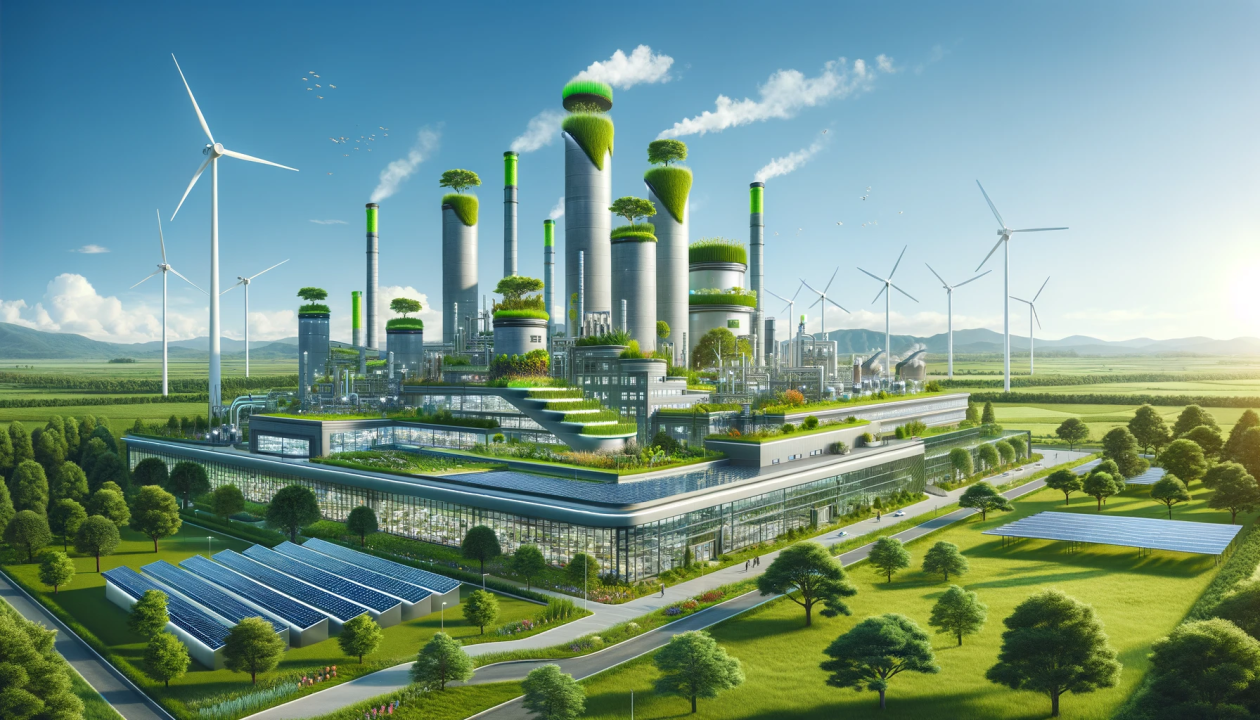
Welcome to the green revolution! In a world where environmental concerns are at the forefront, sustainable solutions have become more important than ever. The power of sustainable chemicals and packaging solutions is being unveiled as we work towards a greener future.
This article dives deep into the realm of sustainable chemicals and packaging, exploring their potential to transform industries and make a positive impact on the planet. From renewable materials to biodegradable alternatives, these solutions offer innovative ways to reduce our carbon footprint and minimize waste.
Discover the endless possibilities of sustainable materials and their ability to replace harmful chemicals in various industries. Explore how eco-friendly packaging solutions can not only protect products but also minimize environmental impact. Learn how businesses are embracing these sustainable alternatives to meet consumer demand for greener products.
Join us on this journey as we explore the green revolution and uncover the power of sustainable chemicals and packaging solutions. Together, we can create a more sustainable future for generations to come.
The Environmental Impact of Traditional Chemicals and Packaging
The widespread use of traditional chemicals and packaging has had a significant negative impact on the environment. These chemicals, often derived from fossil fuels, release harmful pollutants into the air and water during production and disposal. Additionally, the production of traditional packaging materials, such as plastic, contributes to the depletion of natural resources and the accumulation of non-biodegradable waste.
The effects of these practices are far-reaching. Air pollution from chemical production contributes to climate change and respiratory diseases. Water pollution harms aquatic ecosystems and endangers the health of both marine life and humans. Plastic waste, which takes hundreds of years to decompose, accumulates in landfills, pollutes oceans, and poses a threat to wildlife.
The Benefits of Sustainable Chemicals and Packaging Solutions
Sustainable chemicals and packaging solutions offer a range of benefits that address these environmental concerns. By utilizing renewable resources, these alternatives reduce our dependence on fossil fuels and minimize greenhouse gas emissions. Additionally, sustainable chemicals are designed to have a lower environmental impact throughout their life cycle, from production to disposal.
One of the remarkable benefits of sustainable chemicals is their ability to replace harmful substances in various industries. For example, in the agricultural sector, bio-based pesticides and fertilizers offer effective alternatives to synthetic chemicals, reducing soil and water contamination. Similarly, in the cosmetics industry, natural and organic ingredients can replace potentially harmful synthetic compounds, promoting healthier skincare products.
In the packaging realm, sustainable solutions offer innovative ways to protect products while minimizing environmental impact. Biodegradable packaging materials, such as compostable plastics and plant-based alternatives, break down naturally and reduce waste accumulation. Additionally, lightweight packaging designs reduce the need for excessive materials, resulting in energy savings during transportation and distribution.
Sustainable Chemical Alternatives for Various Industries
The potential for sustainable chemicals to transform industries is vast. In the textile industry, for example, traditional dyes and finishes often contain toxic substances that harm both the environment and workers. Sustainable alternatives, such as natural dyes derived from plants or insects, offer a safer and more eco-friendly option. These natural dyes not only reduce pollution but also support local communities engaged in sustainable farming practices.
Another industry that can benefit greatly from sustainable chemicals is the cleaning and sanitation sector. Traditional cleaning products often contain harsh chemicals that can be harmful to human health and the environment. Sustainable alternatives, such as plant-based cleaners and biodegradable detergents, offer effective cleaning solutions while minimizing negative impacts on water systems and aquatic life.
Furthermore, the construction industry can also embrace sustainable chemicals to reduce its carbon footprint. Traditional building materials, such as concrete and steel, have a significant environmental impact due to their high energy consumption and emissions during production. However, sustainable alternatives, such as bio-based materials and recycled content, offer more environmentally friendly options without compromising structural integrity.
Sustainable Packaging Solutions and Innovations
The role of packaging goes beyond protecting products; it is also an opportunity to minimize environmental impact. Sustainable packaging solutions and innovations are revolutionizing the way products are packaged and delivered, reducing waste and promoting a circular economy.
One of the most significant innovations in sustainable packaging is the development of bioplastics. Unlike traditional plastics derived from fossil fuels, bioplastics are made from renewable resources such as corn, sugarcane, or algae. These materials have a lower carbon footprint and can be biodegradable or compostable, offering a more sustainable alternative to traditional plastic packaging.
Additionally, advancements in packaging design have led to the development of lightweight and efficient packaging solutions. By using less material, these designs reduce waste and energy consumption during transportation. Furthermore, innovative designs such as collapsible packaging or refillable containers offer opportunities for reuse, minimizing the need for single-use packaging.
Implementing Sustainable Practices in Manufacturing and Distribution
To fully realize the potential of sustainable chemicals and packaging solutions, it is crucial to implement sustainable practices throughout the manufacturing and distribution processes. This involves adopting cleaner and more efficient production methods, optimizing resource usage, and minimizing waste generation.
One way to achieve this is through the adoption of green chemistry principles. Green chemistry focuses on designing chemical processes that minimize the use and generation of hazardous substances. By prioritizing sustainability and safety, green chemistry aims to reduce the environmental impact of chemical production while maintaining product performance.
Furthermore, implementing sustainable practices requires collaboration along the entire supply chain. Manufacturers can work closely with suppliers to source sustainable raw materials, ensuring the integrity and environmental impact of the products they create. Additionally, partnerships with logistics providers can help optimize transportation routes and reduce emissions during distribution.
Case Studies of Companies Leading the Way in Sustainable Chemicals and Packaging
Several companies have already embraced sustainable chemicals and packaging solutions, setting an example for others to follow. One such company is Patagonia, a leading outdoor apparel brand. Patagonia has made significant efforts to reduce its environmental impact by using recycled materials, natural dyes, and sustainable packaging. Their commitment to sustainability has not only attracted environmentally conscious consumers but also inspired other companies to follow suit.
Another notable example is Ecover, a cleaning products company that prioritizes sustainability throughout its entire product range. Ecover offers a range of plant-based cleaners and detergents that are biodegradable and have a lower impact on water systems. The company also uses recycled plastic in its packaging and has implemented refill stations to reduce single-use packaging waste.
The Role of Government Regulations in Promoting Sustainable Practices
Government regulations play a crucial role in promoting sustainable practices in the chemical and packaging industries. By implementing regulations that encourage the use of sustainable alternatives and restrict the use of harmful substances, governments can drive industry-wide change.
For example, the European Union has implemented regulations such as REACH (Registration, Evaluation, Authorization, and Restriction of Chemicals) to ensure the safe use of chemicals and encourage the development of safer alternatives. Similarly, numerous countries have implemented bans or restrictions on single-use plastics, driving the adoption of sustainable packaging alternatives.
Government subsidies and incentives can also encourage businesses to adopt sustainable practices. By providing financial support for research and development of sustainable alternatives, governments can help accelerate the transition towards greener solutions. Additionally, tax incentives for businesses that adopt sustainable practices can provide further motivation for companies to embrace sustainability.
Challenges and Obstacles in Transitioning to Sustainable Chemicals and Packaging
While the potential of sustainable chemicals and packaging solutions is vast, there are challenges and obstacles that need to be addressed for a successful transition. One of the main challenges is the cost of sustainable alternatives, which can be higher than traditional options due to factors such as limited production scale and higher raw material costs. However, as demand for sustainable products grows and production scales increase, costs are likely to decrease.
Another obstacle is the lack of awareness and education among consumers. Many individuals are not fully aware of the environmental impact of traditional chemicals and packaging, making it difficult for sustainable alternatives to gain traction. Education and awareness campaigns can help bridge this gap and empower consumers to make more sustainable choices.
Additionally, transitioning to sustainable chemicals and packaging requires collaboration and coordination among various stakeholders. This includes manufacturers, suppliers, retailers, consumers, and policymakers. Building partnerships and fostering a collective commitment to sustainability is essential for overcoming obstacles and driving meaningful change.
Conclusion: Embracing the Green Revolution for a Brighter Future
The green revolution is here, and sustainable chemicals and packaging solutions are leading the way towards a greener future. By replacing harmful chemicals and reducing waste, these alternatives offer innovative ways to protect the environment and promote a more sustainable society.
Through the adoption of sustainable practices in manufacturing and distribution, businesses can make a significant impact on reducing their carbon footprint and minimizing waste generation. Governments also play a crucial role in driving industry-wide change through regulations and incentives that promote sustainable practices.
As consumers, we have the power to drive demand for greener products and support companies that prioritize sustainability. By choosing products with sustainable chemicals and packaging, we can contribute to a more sustainable future for ourselves and future generations.
Join the green revolution and embrace the power of sustainable chemicals and packaging solutions. Together, we can create a brighter future for our planet.


